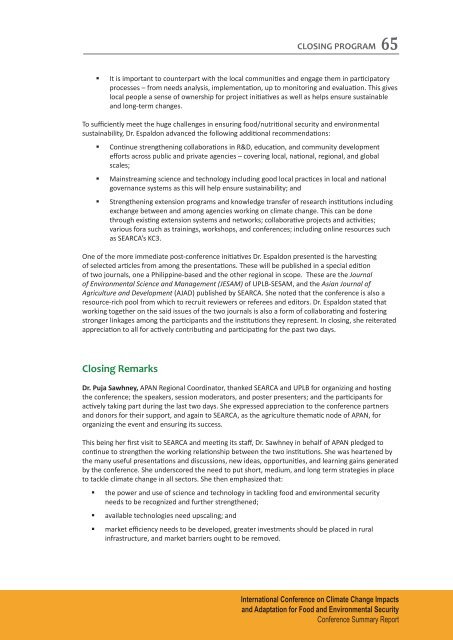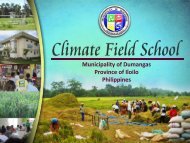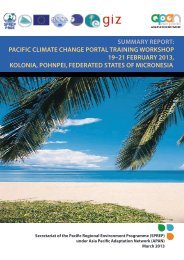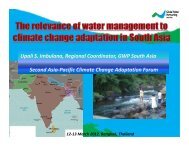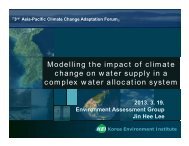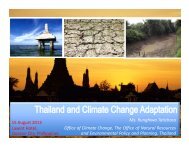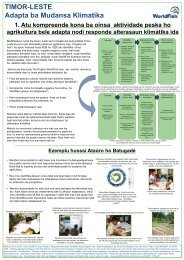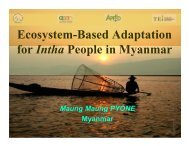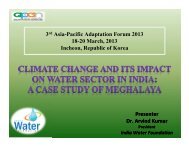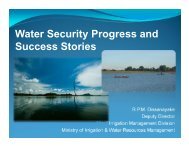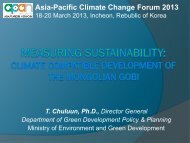PDF file (2.44 MB) - Asia Pacific Adaptation Network
PDF file (2.44 MB) - Asia Pacific Adaptation Network
PDF file (2.44 MB) - Asia Pacific Adaptation Network
Create successful ePaper yourself
Turn your PDF publications into a flip-book with our unique Google optimized e-Paper software.
CLOSING PROGRAM65• It is important to counterpart with the local communities and engage them in participatoryprocesses – from needs analysis, implementation, up to monitoring and evaluation. This giveslocal people a sense of ownership for project initiatives as well as helps ensure sustainableand long-term changes.To sufficiently meet the huge challenges in ensuring food/nutritional security and environmentalsustainability, Dr. Espaldon advanced the following additional recommendations:• Continue strengthening collaborations in R&D, education, and community developmentefforts across public and private agencies – covering local, national, regional, and globalscales;• Mainstreaming science and technology including good local practices in local and nationalgovernance systems as this will help ensure sustainability; and• Strengthening extension programs and knowledge transfer of research institutions includingexchange between and among agencies working on climate change. This can be donethrough existing extension systems and networks; collaborative projects and activities;various fora such as trainings, workshops, and conferences; including online resources suchas SEARCA’s KC3.One of the more immediate post-conference initiatives Dr. Espaldon presented is the harvestingof selected articles from among the presentations. These will be published in a special editionof two journals, one a Philippine-based and the other regional in scope. These are the Journalof Environmental Science and Management (JESAM) of UPLB-SESAM, and the <strong>Asia</strong>n Journal ofAgriculture and Development (AJAD) published by SEARCA. She noted that the conference is also aresource-rich pool from which to recruit reviewers or referees and editors. Dr. Espaldon stated thatworking together on the said issues of the two journals is also a form of collaborating and fosteringstronger linkages among the participants and the institutions they represent. In closing, she reiteratedappreciation to all for actively contributing and participating for the past two days.Closing RemarksDr. Puja Sawhney, APAN Regional Coordinator, thanked SEARCA and UPLB for organizing and hostingthe conference; the speakers, session moderators, and poster presenters; and the participants foractively taking part during the last two days. She expressed appreciation to the conference partnersand donors for their support, and again to SEARCA, as the agriculture thematic node of APAN, fororganizing the event and ensuring its success.This being her first visit to SEARCA and meeting its staff, Dr. Sawhney in behalf of APAN pledged tocontinue to strengthen the working relationship between the two institutions. She was heartened bythe many useful presentations and discussions, new ideas, opportunities, and learning gains generatedby the conference. She underscored the need to put short, medium, and long term strategies in placeto tackle climate change in all sectors. She then emphasized that:• the power and use of science and technology in tackling food and environmental securityneeds to be recognized and further strengthened;• available technologies need upscaling; and• market efficiency needs to be developed, greater investments should be placed in ruralinfrastructure, and market barriers ought to be removed.International Conference on Climate Change Impactsand <strong>Adaptation</strong> for Food and Environmental SecurityConference Summary Report


